The Ultimate Guide to Hiking Minaret Lake (in the Stunning Sierra Nevadas)
The Minaret Lake hike is the perfect way to get a taste of the stunning Sierra Nevadas on a short backpacking trip. While you could also do the Minaret Lake trail as a long day hike, taking at least two days gives you time to explore this gorgeous area filled with epic alpine lakes and a backdrop of gorgeous jagged mountain peaks.
Pro Tip: It’s totally worth it to wake up early to catch the sunrise hitting the Minarets in the morning!
The cover photo for this post is from me waking up around 5 AM on my trip with my best friend to this area. I set an alarm and snuck out of my tent to brave the windy cold morning in order to capture a picture and take in one of the most beautiful things I’ve ever seen. Then I went back to bed! ha! So worth the early wake-up call though.
WHAT WE WILL COVER IN THIS GUIDE:
If you’re looking for a great intro backpacking trip in the Sierra Nevada, the Minaret Lake trail is it! This section of the John Muir Trail is a non-technical trail on the Native lands of Northern Paiute, Western Mono/Monache, and Eastern Mono/Monache.
>>>For more incredible trails in the Sierra Nevada, check out my top ten Eastern Sierra hikes!
Minaret Lake features gorgeous views everywhere you turn. You can plan this trip as one or two nights, depending on the time you have to spend in this amazing alpine setting.
In this post, we will cover the following topics to help you plan and prepare for your very own successful Minaret Lakes backpacking adventure:
Minaret Lake Trail Stats - All the nitty gritty details for the trail in one spot. How many miles, elevation gain, & more.
Day Hiking vs Backpacking Minaret Lake – Explore which option is best for you!
How to Get a Minaret Lake Permit – The step-by-step process to get the required Minaret Lake permit for backpacking.
When to Hike Minaret Lake – The best time to hike Minaret Lake and typical weather to expect on your trip.
Minaret Lake Hike Map & GPX Files - I've created a map detailing the entire trail that you can explore, including a look at the elevation gain/profile of the hike. You can also download this file as a GPX file to upload into your own personal GPS device.
How to Get to the Minaret Lake Trailhead – Driving and parking recommendations.
Camping Near Minaret Lake – Where to camp on and off the trail.
Itinerary for Hiking the Minaret Lake Trail - I’ll walk you through a suggested itinerary for backpacking the trail so you can make your plans accordingly.
Important Minaret Lake Safety Tips – Tips about the top hazards to expect along the Minaret Lake trail.
What to Bring on Your Minaret Lake Backpacking Trip – The essential packing list for your Minaret Lakes hike – don’t hit the trail without these things!
If you’re looking for specific information, feel free to skip ahead to the section you’re looking for!
Plus, be sure to check out the bottom of this post to find more hiking trail guides in California and other additional hiking, camping, and backpacking resources!
GRAB MY [FREE] OUTDOOR BACKPACKING STARTER KIT
I created the Ultimate Outdoor Backpacker Starter Kit for you (and it's FREE)! This starter kit is filled with 14 pages of my best hiking and backpacking tips to help you learn what it takes to become a safe, confident, and self-sufficient outdoor backpacker!
1. MINARET LAKE TRAIL STATS
If you’re anything like me, the first thing you want to know about a trail is the important stats and information, so you can quickly figure out what the hike is all about.
MINARET LAKE TRAIL QUICK FACTS
Minaret Lake Elevation: 9,833 feet
Trail to Area: John Muir Trail
Type of Trail: Out & Back
How long is the hike to Minaret Lake: 13.4 miles (If Reds Meadow Gate is closed, you will have to hike several more miles to reach the trailhead.)
Total Elevation Gain: 2,586 feet
Minaret Lake Trailhead: Devils Postpile
Trailhead Elevation: 7,556 feet
How long does it take to hike Minaret Lake? It takes approximately 8 hours to do this as a day hike.
Minaret Lake crowds: You probably won’t be alone on this trail, but the crowds usually aren’t too bad overall.
Do you need a permit to hike Minaret Lake? Permits are required if you are backpacking & camping, but not for day hiking this trail.
How difficult is hiking Minaret Lake? Moderate to strenuous. This trail has some elevation gain, but it’s fairly spread out over the whole hike.
How dangerous is hiking Minaret Lake? Hiking to Minaret Lake is not particularly dangerous, as it is not at all technical, but be careful at the stream crossing.
Is there drinking water available along the Minaret Lake hike? Yes, there are creeks and lakes you can filter water from.
Is hiking Minaret Lake dog-friendly? Yes! Your furry friend can join you on this trail (just be prepared to navigate a possible stream crossing).
Is hiking Minaret Lake kid-friendly? While this hike is not extremely difficult, it is long, especially as a day hike, which could be too much for younger kids.
2. DAY HIKING VS BACKPACKING MINARET LAKE
The trail to Minaret Lake can be done as either a long day hike or a one-night backpacking trip. Here we’ll go over the pros and cons of each option.
DAY HIKING MINARET LAKE
Hiking to Minaret Lake out & back definitely makes for a long day, but it is doable. This is a good choice if you don’t have a lot of time in the area or if you’re looking for a challenging day for training. Also, you don’t have to worry about getting a wilderness permit if you day hike.
BACKPACKING MINARET LAKE
Backpacking to Minaret Lake lets you savor the beauty of the area. You’ll get to experience a gorgeous sunrise and stunning sunset in the Sierra Nevada, and that alone might make it worth it. Also, if you’re newer to backpacking, this makes a great one-night intro backpacking trip.
You will have to plan ahead in order to backpack, since an Inyo Wilderness permit is required in order to camp. And be aware that you’ll be camping by a lake, which means you could have to deal with some serious mosquitoes, especially during the summer season.
3. HOW TO GET A MINARET LAKE PERMIT
If you choose to backpack to Minaret Lake, you will need to get an Inyo National Forest Wilderness permit in order to camp overnight. Here’s what you need to know to get your permit:
WHEN TO APPLY
The Inyo Wilderness permits for most trails including Minaret Lake can be reserved up to 6 months in advance. This means that for reservations in the summer months (July through October), you will be able to make reservations from January to April.
There is a 10 person (6 reservation and 4 walk-in) daily permit quota for the Minaret Lake Trail from June to mid-September. More details on the quota can be found on the National Forest Service site.
WHERE TO APPLY
You will apply for your Inyo Wilderness permit through Recreation.gov. If you don’t already have an account on the site, you will need to create one in order to apply.
The “Trail Code” you’ll be applying for is Minaret Lake - AA11.
HOW TO APPLY
1) Go to the Recreation.gov website and search for Inyo National Forest Wilderness permits.
2) Click the “Explore Available Permits” button
3) You will then be taken to a long list of trailheads showing their availability and quotas. To narrow your search, use the filters at the top – input “Overnight,” your start date, and group size. You can filter further by typing in “Minaret Lake” or “AA11” into the filter search box. Also, you will need to mark if this is a guided trip or not.
Once you select your filters, you’ll be shown a list of available permits. If there are permits available, they will show up as a number, otherwise they usually show “W” which means walk-in only. You can scroll through a list of dates to see other availability if your original start date isn’t available.
4) If you find an available date that works for you, click on the date, then “Book Now.”
5) At this point, you’ll be taken to an order form page where you will fill in all the necessary information.
6) Finally, you’ll check out and pay for your Minaret Lake permit.
HOW MUCH DOES A MINARET LAKE PERMIT COST?
To finalize your permit reservations, you’ll need to pay a $6 permit fee plus an additional $5 non-refundable per person transaction fee.
>> Find out more about popular California hiking & camping permits here.
4. WHEN TO HIKE MINARET LAKE
I think September is the most wonderful time of the year to hike in the Sierra Nevadas. The temperature is usually perfect, plus there are far fewer mosquitos. July and August are also good options, though it could get pretty hot then, and you’ll definitely want to bring your bug spray.
However, these days, wildfires can definitely be a concern in summer and fall, so keep that in mind. Earlier or later in the season (June or October), you could potentially encounter snow, which would definitely make the trail more of a challenge and potentially be dangerous.
Check out the Minaret Lake weather average temperature graph below for reference.
Be prepared before you go. Just like I teach my students in my backpacking program. It’s important that you research your weather conditions before you go, weeks and days before your trip. You can check the weather conditions here:
Mountain Forecast – One of my favorite resources for mountain weather forecasts when checking a few days before a trip
Important Notes: At the beginning of the Minaret Lake trail, there is a stream crossing that will be higher earlier in the season due to snow melt.
PSST.. ARE YOU READY TO FINALLY UNDERGO YOUR OWN BACKPACKING TRANSFORMATION?
Join me (and your peers) on a transformational adventure, where you will learn how to confidently go on your first ever (or perhaps your first solo) outdoor backpacking trip without the constant fear of getting lost, the debilitating worry of being unprepared, and the lurking feeling that you lack the "know-how" and skills required to stay safe on the trails. Click below to be the first to know when my one-of-a-kind backpacking program re-opens again for enrollment!
5) MINARET LAKE HIKE MAP & GPX FILES
The Minaret Lake trail is fairly easy to follow, but there are a few trail junctions along the way. It’s a good idea to take a GPS map to navigate so you don’t get off course.
I’ve created a map detailing the whole Minaret Lake trail that you can explore, including a look at the elevation gain/profile of the hike. You can also download this file as a GPX file to upload into your own personal GPS device.
I always recommend downloading a GPX file onto a GPS device, that way you can check in from time to time to be sure you’re on the right trail.
You can download the GPX files from the Minaret Lake trail map below. It details all the key milestones of the hike including the trailhead start, summit, and more.
DOWNLOAD THE MINARET LAKE GPX FILES FOR YOUR GPS HERE:
Knowledge is power my friend, and I'm a girl who loves data. Get access to this trails GPX file PLUS my library of GPX files with tracks and waypoints for all the trails loaded onto the She Dreams of Alpine blog.
Load this puppy into your trusted GPS and rest easy knowing you have tracks to follow on your next hike or backpacking trip.
DON’T HAVE A GPS? YOU SHOULD.
I believe every hiker and backpacker should strive to be self-sufficient, and that includes knowing how to practice smart navigational skills in the outdoors.
This is an important safety skill set that I teach in-depth inside of my backpacking program. There’s no reason to risk getting lost in the outdoors.
Here’s what I recommend to get started:
(Note: This list contains affiliate links)
Gaia is offering a special 10% discount on a premium account to those who subscribe online through my link.
Don’t know where to start? If you need help with some Gaia GPS basics, download my quick Gaia GPS navigation 101 guide.
2) Get an SOS Device: Once you are able to, I recommend investing in some sort of SOS communication device like the Garmin inReach Mini or the Garmin inReach Explorer+ . These devices provide not only GPS tracking capabilities, but also an SOS satellite search and rescue communicator and text communication abilities in the backcountry.
My Go-To Trail Setup: The Gaia GPS app (premium subscription) + the Garmin inReach Mini.
Alternative to Garmin: Pair your Gaia GPS App with the Zoleo SOS device . With this set up, the Gaia GPS App serves as your GPS navigation device, and the Zoleo serves as an SOS/communication device.
Learn more about the best GPS devices for hiking here.
MINARET LAKE HIKE ELEVATION PROFILE
Here’s a look at the Minaret Lake hike elevation gain profile from the trailhead to the lake and back.
>> JUMP TO SECTION 8 FOR A SUGGESTED MINARET LAKE TRAIL ITINERARY.
6) HOW TO GET TO THE MINARET LAKE TRAILHEAD
You will start the Minaret Lake hike at the Devils Postpile Ranger Station. To be completely honest, getting to the Minaret Lake trailhead can be a bit of a hassle. It’s not hard to do, but it does require a little planning ahead.
Note: A large reconstruction project is underway on Reds Meadow Road that will last through the 2024 hiking season, and this will affect access to Minaret Lake. Find out more details about the Reds Meadow Road Reconstruction Project at the US Forest Service site here.
PARKING
There is very limited parking at the ranger station, and you are only allowed to drive your own vehicle to the trailhead if you arrive before 7am and are day hiking. If you’re backpacking or starting later in the day, you must use the shuttle service instead. You will have to pay a $10 day pass fee if you drive yourself (unless you have a National Parks pass).
SHUTTLE
Most people hiking to Minaret Lake will need to take the Reds Meadow/Devils Postpile shuttle to access the trailhead. The shuttle generally runs from mid-June to sometime in September.
You purchase your $15 round-trip ticket and get on the shuttle at the Mammoth Mountain Adventure Center (make sure to keep your ticket for the return trip!). You will find free parking in the lots near the Mammoth Lodge.
Get off the shuttle at Stop #6, Devils Postpile. You can stop for water or to use the bathroom at the ranger center, then begin your hike right from there.
7. CAMPING NEAR MINARET LAKE
You’ll find lots of great camping options for Minaret Lake, whether you just want to camp at the trailhead before or after a day hike, or if you’re camping along the trail while backpacking.
WHERE TO CAMP NEAR THE TRAILHEAD
Mammoth Lakes offers many camping options, from developed campgrounds to dispersed camping. Right in the town of Mammoth are Camp High Sierra, New Shady Rest Campground, and Old Shady Rest Campground, which offer paid sites with amenities including bathrooms and bear boxes. Just outside of town, there is plenty of BLM land and National Forest Service land, both of which allow free dispersed camping.
Reds Meadow campground is also an awesome option, if you’re lucky enough to actually score a spot. This campground is very close to the trailhead and has 52 first-come, first-serve sites.
>>>If you’re looking for more amazing hikes in the area, check out our guide to 30 spectacular hikes in Mammoth Lakes!
WHERE TO CAMP ON THE TRAIL
When backpacking to Minaret Lake, you’ll want to camp near the lake itself (especially on the east side) for the most breathtaking views. You’ll find plenty of places to stake your tent, but be aware of Leave No Trace rules, and camp at least 200 feet from the water. You should also set up your camp in a spot where people have clearly camped before, in order to minimize environmental impact.
8) ITINERARY FOR HIKING THE MINARET LAKE TRAIL
Here I’ll walk you through a suggested itinerary for backpacking the Minaret Lake trail, so you can make your plans accordingly.
A TYPICAL MINARET LAKE BACKPACKING ITINERARY
I recommend a 2-day itinerary for the Minaret Lake hike. The one-way hike to Minaret Lake won’t take the whole day, so this trip will still give you time to relax and explore the area further if you want.
Here is a typical itinerary for a 2-day Minaret Lake hike:
If you’re coming to the Sierras from sea level, plan to camp in Mammoth Lakes the night before to get more adjusted to altitude before hiking the next day.
In the morning, get energized with strong coffee and yummy breakfast burritos at Stellar Brew. But be sure to get up early to try to make it to the trailhead before 9am to grab parking. If you have more than one car in your group, leave one of your cars up at Minaret Vista and carpool to the trailhead to have a better chance of getting a spot.
Then you’ll hit the trail and hike to Minaret Lake, which shouldn’t take you more than 4-5 hours, since it’s a pretty chill gradual incline up to Minaret Lake. When you arrive at the alpine lake, you can scope out the best site to set up camp and spend your day relaxing at the lake. Or, if you have more energy, you could also hike a little more around the area – maybe even up to Cecil Lake. Make sure you take some time to enjoy what is sure to be a spectacular Sierra Nevada sunset.
After waking up early to catch the sunrise over the lake the next morning, head back down the trail and hike out. Then celebrate your adventure by heading to Mammoth Lakes for hearty burgers and excellent beers from Mammoth Brewing!
9) IMPORTANT MINARET LAKE SAFETY TIPS
The hike to Minaret Lake is not a technical hike, but you should still pay special attention to the following potential safety hazards, and be sure to plan ahead accordingly.
ALTITUDE SICKNESS
While Minaret Lake is certainly not the highest point in the Sierra Nevadas, the trailhead starts at around 7,500 feet elevation, and you’ll end up all the way up at 9,800 feet when you reach Minaret Lake. Although this probably won’t cause altitude sickness, it could make the hike much more of a struggle if you’re coming from sea level. In that case, it’s probably worth spending a night in Mammoth Lakes before the hike in order to give your body a little time to adjust.
SNOW
Depending on the season you choose to hike Minaret Lake, you could encounter snow on the trail, which could make the hike more technical and potentially treacherous. In the middle of the summer, the trail should be clear and melted out, but early in the summer or in the fall, you should definitely check the updated trail conditions and snowfall totals for the season before you attempt this hike.
MOSQUITOES
While the summer months of July and August make for great trail conditions, they also are the months when you will find the most mosquitoes. In this area, mosquitoes can be a massive nuisance and make your hike pretty miserable, so be sure to bring bug spray and potentially even insect-repellent clothing if you’re hiking in the height of summer. Also, if you’re backpacking, set up your camp farther away from water, where wind will help keep some of the mosquitoes away.
STREAM CROSSING
Near the beginning of this trail, you will come to a stream crossing near Johnston Lake. Later in this season, the water level should be low, and the crossing shouldn’t be an issue at all, but early in the season, you will want to be careful making this crossing. When Michael & I did this hike in late June, the stream was about knee high and VERY cold. Hiking poles could definitely come in handy here to maintain your balance in the water on slippery rocks.
WILDLIFE
This area of the Eastern Sierras is filled with a variety of wildlife, but the biggest concern is black bears. Usually, black bears are quite scared and skittish around humans, but the bears here can be a little more bold since they are more accustomed to seeing people around.
As with all bears, you should practice standard bear safety principles including (but not limited to) the following:
Make noise while you hike so wildlife is never startled by your presence.
Always keep your distance if you see a bear.
Never run from a bear.
Always store your food (and any other scented items) at night in either a bear box or bear canister.
Rangers ask that you don’t bring bear spray with you in this area. Just be smart, make noise while you hike, and you’ll likely avoid a bear encounter.
And definitely don’t leave food in your car at the trailhead – use a bear locker for anything you don’t bring with you on the trail.
10) WHAT TO BRING ON YOUR MINARET LAKE BACKPACKING TRIP
To prepare and pack for backpacking Minaret Lake, I’d love for you to pop over to my backpacking gear checklist and make sure you have everything you need for your trip.
And there are a few absolutely essential items I want to make sure you have ready to go when you’re heading out on your Minaret Lake adventure.
*Please note that some of the below links and in this post are affiliate links.
Again, this is not all the gear you need, so be sure to check out my backpacking gear checklist for my entire list of gear recommendations!
DOWNLOAD OUR BACKPACKING PACKING CHECKLIST:
Never leave any crucial items behind before you head out on a backpacking trip! I’ve written down all the essentials here for you so that you’ll never forget anything vital. PLUS, I love to spoil my readers with a little bit extra as well, so I’ve included a list of 20+ of my favorite backpacking food snacks and meals inside of this list for inspiration.
Now you’re ready to hit the trail and have a fantastic adventure hiking to Minaret Lake! And if you’ve done this hike before, share your experience in the comments!
LOOKING FOR MORE CALIFORNIA ADVENTURES?
If you are looking for additional California hiking adventures, check out our resources below:
ESSENTIAL HIKING (OR BACKPACKING) RESOURCES
Also be sure to check out these essential hiking resources!
7 Tips to Hiking and Summitting Your First Fourteener Mountain
California backpacking permit process for popular trails and campsites
Cheers,
Allison - She Dreams of Alpine









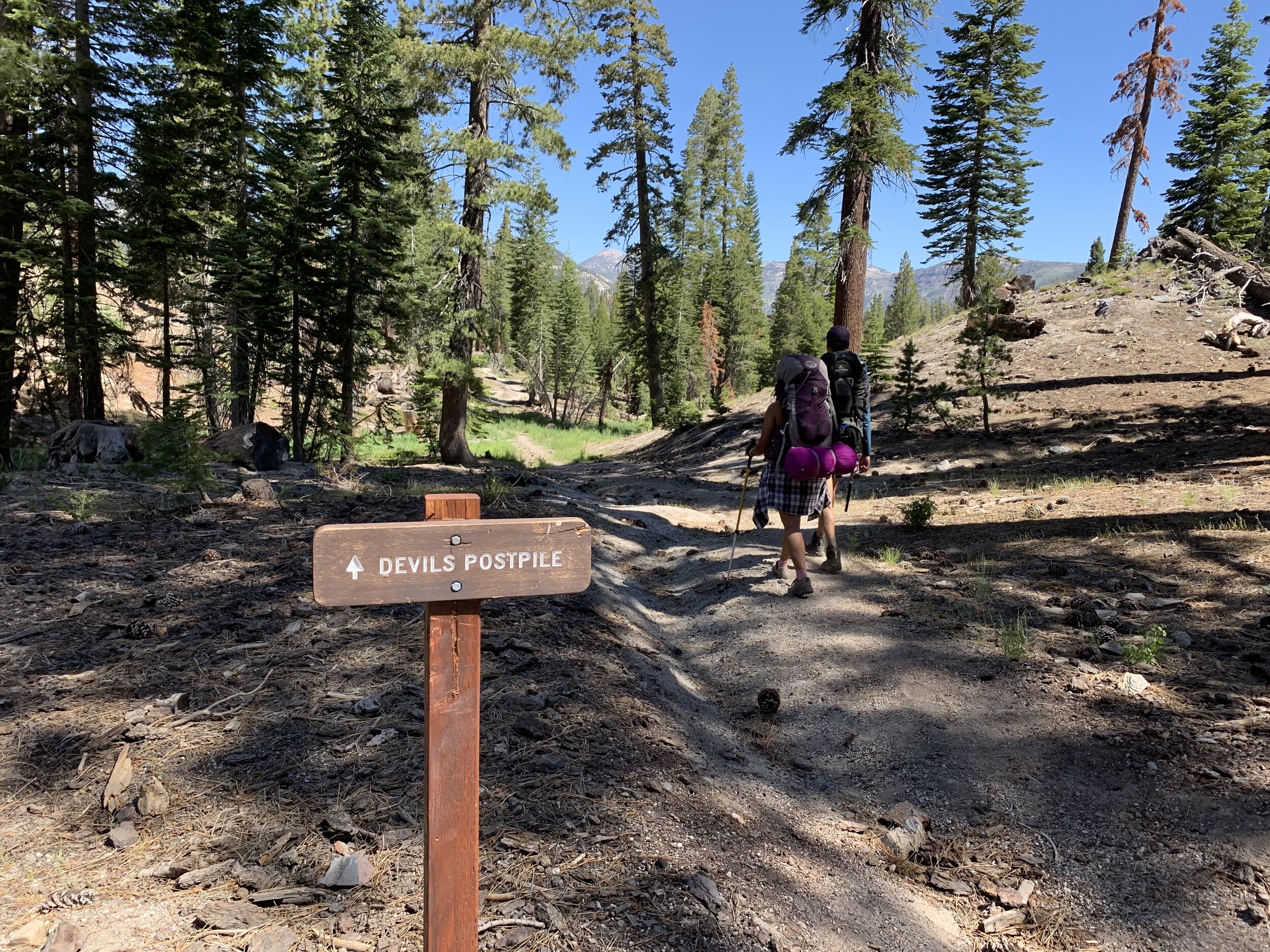




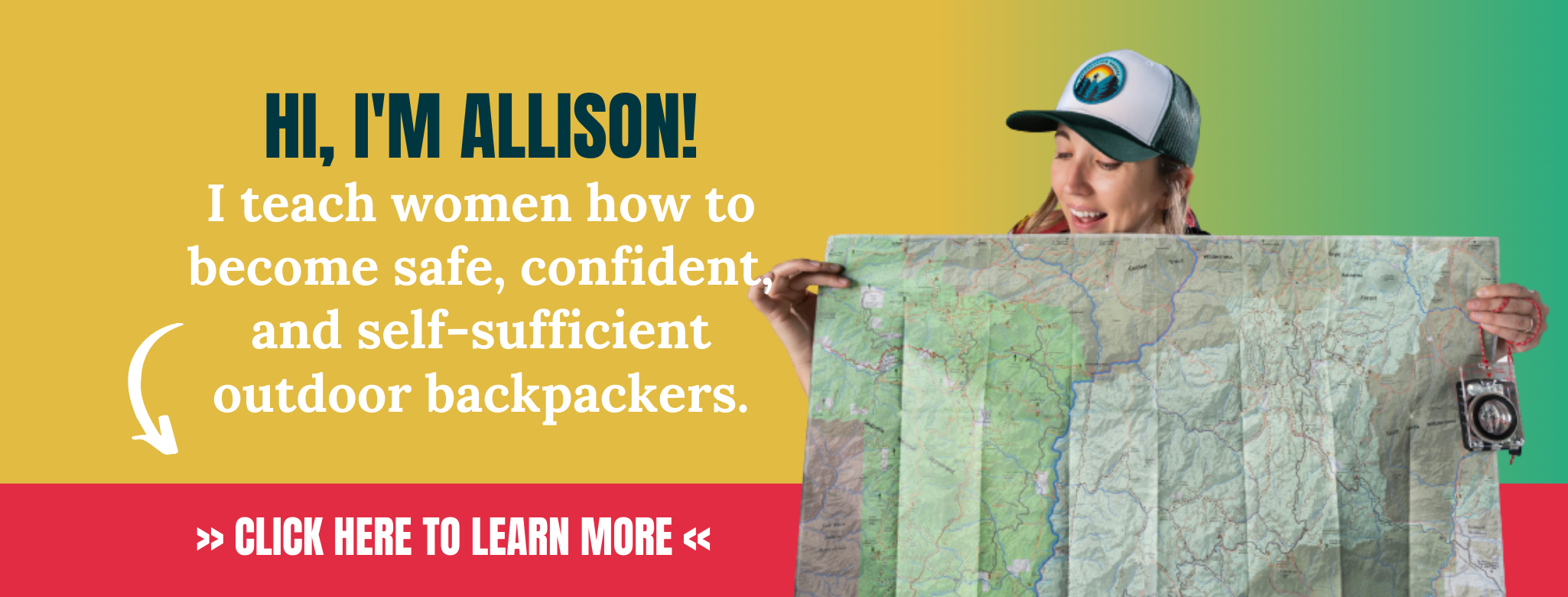

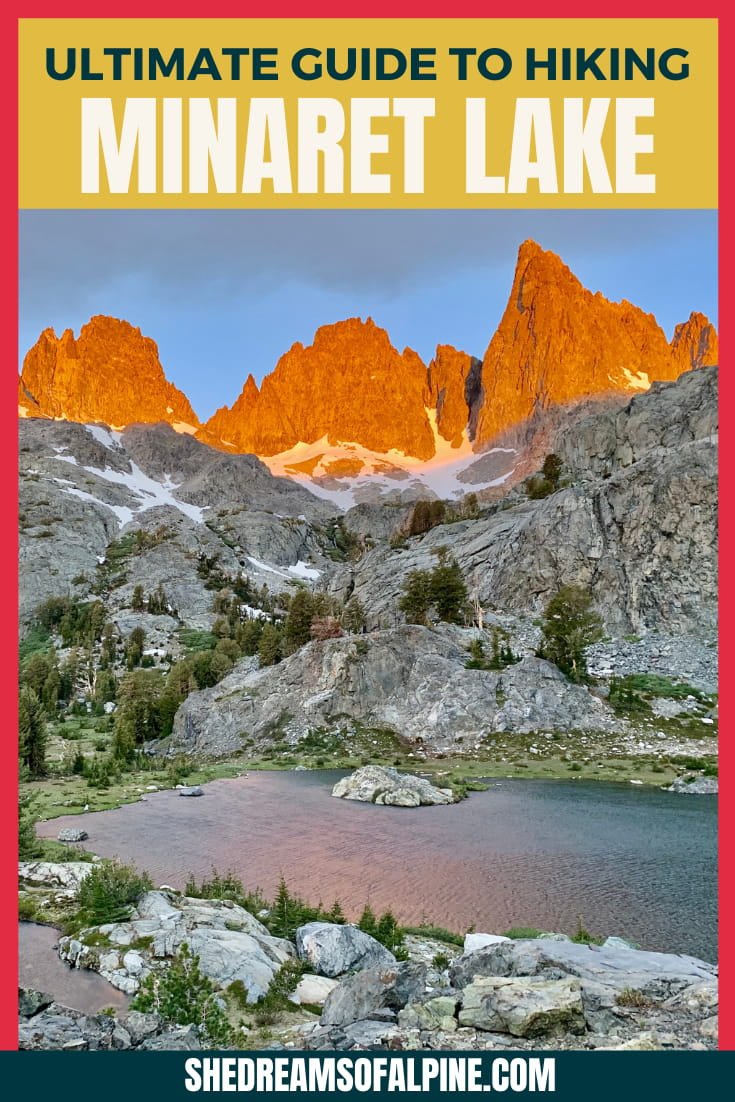
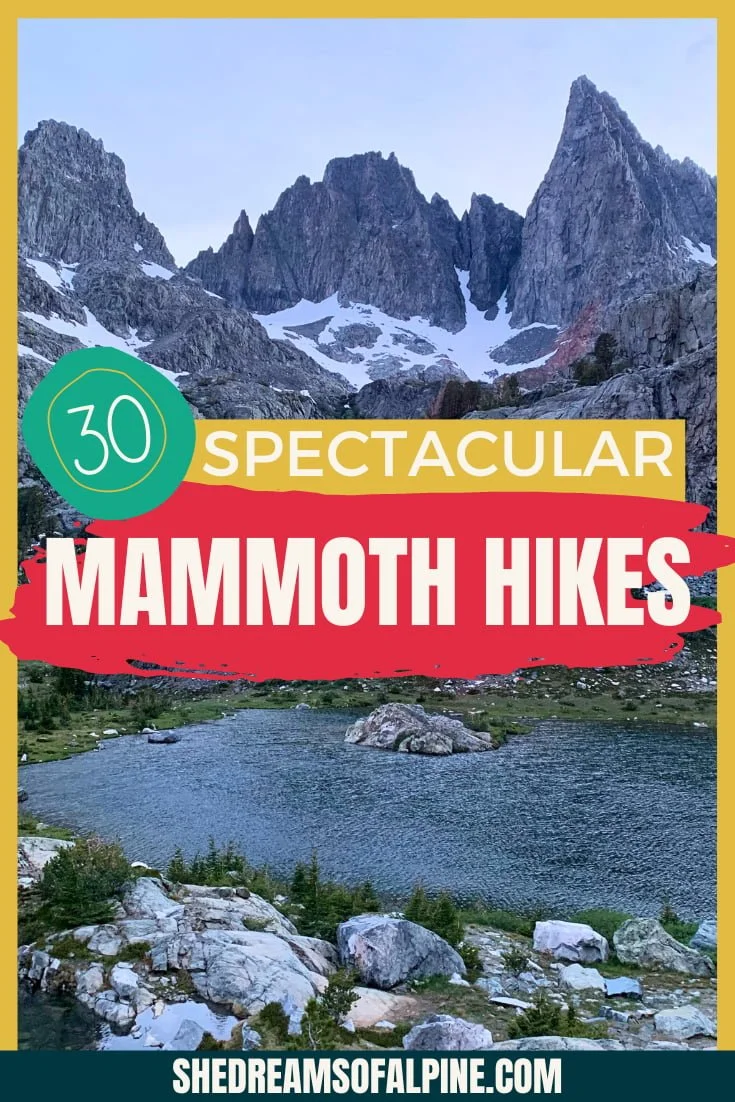
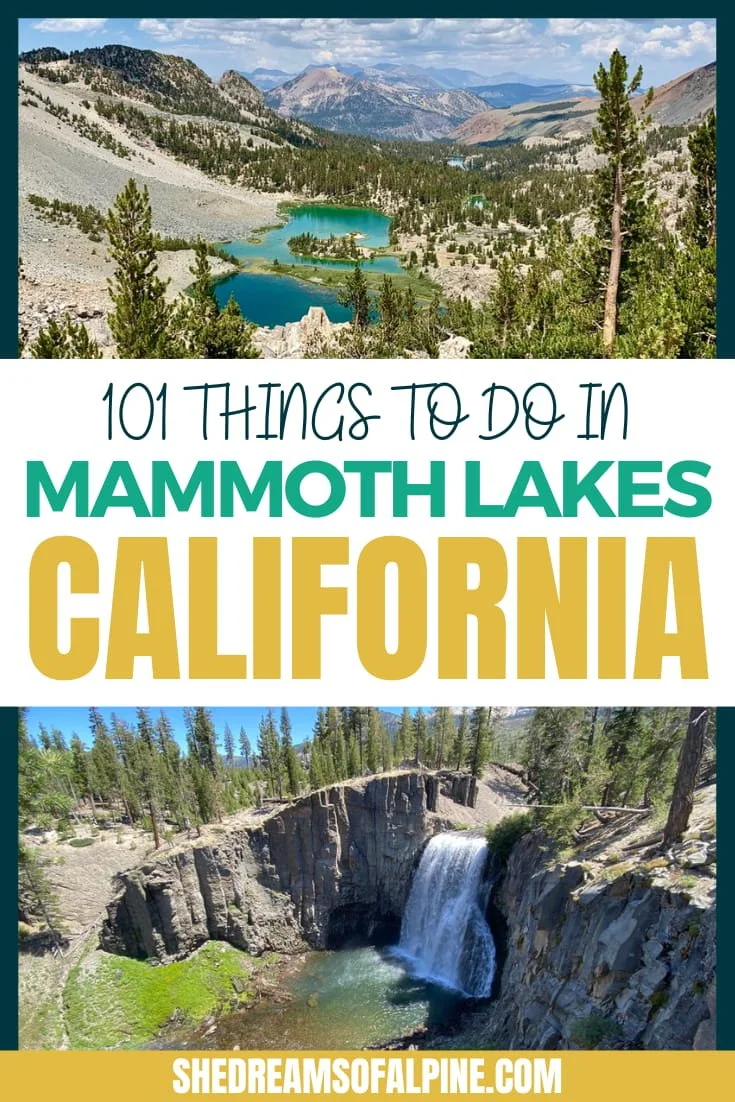



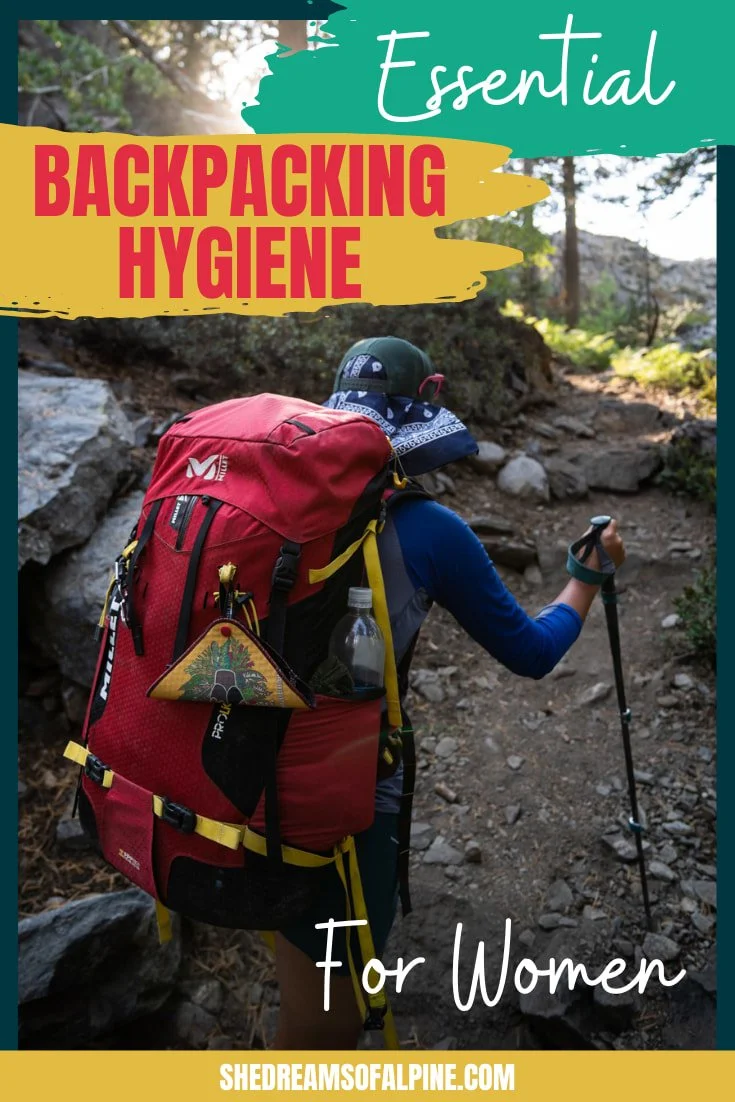


27 of the Absolute Best Hikes in Yosemite National Park to Put on Your Hiking Bucket List | Yosemite National Park is one of the most beautiful national parks in the entire United States, and one of the best ways to explore the park is via one the many amazing hiking trails. In this post, I’ve detailed 27 of Yosemite’s top hiking trails, ranging from difficult to easy, that give you epic views of Yosemite’s grand backcountry and some of Yosemite’s most famous landmarks. You’ll only fall more in love with Yosemite after going on one of these hikes! | shedreamsofalpine.com